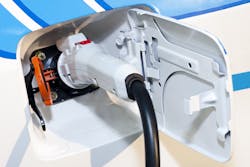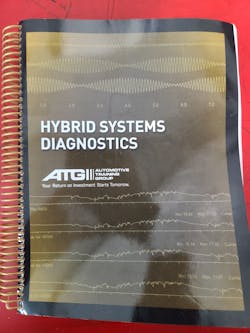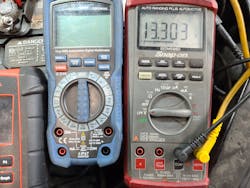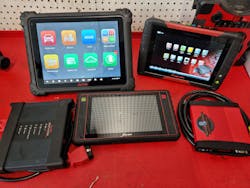Do you have the right tools for an EV repair job?
What You’ll Learn:
- How to find and evaluate information needed for safe and proper repairs
- Evaluating tooling capabilities and needs, including software re-programming abilities
- Evaluating connector and wiring faults – when to repair vs. replace
Hybrids and electric vehicles (EV) are becoming a larger share of the vehicle market, meaning repair facilities are handling more routine service and repair work. There is no doubt that they can be a viable profit center for an appropriately trained and equipped business.
Understanding system operation and safety precautions have never been more critical with the high voltages found in EVs and hybrids. While a conventional vehicle's electrical system is operated entirely on a 12V DC system, today's electrified vehicles may produce five or more different circuit voltages, ranging from 12V to 650V. We can expect to see both AC (alternating current) and DC (direct current) within these voltage ranges. Combining these variable voltages and currents with dozens of interconnected modules makes diagnosing and repairing these systems much more dependent on a healthy level of education and the proper selection and utilization of tooling.
Education and service information
Those currently on the dealership side have access to OE training, which provides in-depth product-specific training not generally available to those on the independent side. Some manufacturers, including Toyota, Honda, and Ford, allow the aftermarket to access online training as part of service information subscriptions or at an affordable price. This is a significant first step in building your knowledge base, but continuing education is needed regardless of being a dealership or independent technician. This is where aftermarket training comes in, be it national training events such as the Vision Hi-Tech Training event, smaller state, or local events such as our own Super Saturday here in Pennsylvania, along with classes presented by companies such as CarQuest Technical Institute (CTI), WorldPAC Technical Institute (WTI) and the Automotive Training Group (ATG). The information gleaned from these classes, books, and instructors are invaluable.
Once you have a strong understanding of the basics needed, you are in a much more suitable position to search and analyze service information (SI) to diagnose faults and perform proper repairs. There are well-known aftermarket SI providers such as ALLDATA, Mitchell, and Motologic, and OEM information systems available through subscription-based models, most extremely affordable, especially if your shop does a high volume in specific brands. These sources will walk you through proper high voltage (HV) disconnect and isolation procedures, along with the theory of operation and repair procedures.
Now that we’ve got a handle on education and SI and where to access it, let’s focus on one of the essential tools in a modern repair shop: a digital multimeter and a lab scope, depending on the measurements being taken.
Digital multimeter and lab scope
What do we need to know about the multimeter we use on hybrids and EVs? The most critical baseline for choosing a meter is its rating. Meters are rated for different voltages on a scale from CAT I to CAT IV. When working with HV systems (generally defined as anything over 50V), there are a couple of rules to remember, with the most important being having a meter, leads, and rubber insulating gloves, which must all have a voltage rating over the highest voltage contained within a system. This requires a CAT III or CAT IV meter rated for at least 600V input. Keep in mind that any accessory kits, such as back probes or alligator clips, should also be rated appropriately for the voltage they will be used to measure. These accessories will have a stamping or marking indicating their CAT rating. Alligator clips are especially useful in HV work as a means of adherence to the “one-hand rule,” which states that only one hand at a time should be in contact with a lead or a ground point while working on HV systems to prevent potential electrocution. Depending on the level of diagnosis being undertaken, a milliohm meter and insulation tester will also be required.A quick reminder: Always check your meter and leads before verifying the proper disconnect of the high voltage systems. Turn your meter to the “Volts DC” setting and measure a known low voltage source, usually the 12V battery of the vehicle. This proves the correct operation of the meter and leads, preventing us from experiencing a false “zero” condition that could be potentially hazardous.
Aftermarket or OE scan tool
An OE or professional level scan tool is an absolute must when dealing with modern vehicles, and as such, there are few shops left without at least one scan tool. Modern hybrid and electric cars were designed in such a way as to nearly eliminate the need for direct measurements of “hot” high-voltage circuits. What does this mean for technicians? It means there is an abundance of data available at our fingertips which will allow proper evaluation and pin-pointing of various faults directly from the driver’s seat with minimal need to interact or disassemble components. A scan tool that can be trusted is our gateway to this information.
The hardest part is choosing the “best” scan tool for the job. I’ll be honest here; there is no single best scan tool – each has its strengths and weaknesses. Thankfully, there are a variety of options available in the aftermarket which allow one to build an excellent base to cover a wide range of vehicles and needed functionalities with many high-level tools now coming equipped with a J2534 or J-Box communications device. This allows for Pass-Thru programming utilizing OE diagnostic software, which is available via subscriptions. After all, many repairs to modern vehicles can be made by reprogramming their operating code in any given module. OE scan tool hardware is also available to the aftermarket, generally at affordable prices, due to Right to Repair legislation allowing near-complete OE level diagnostics and programming.
For instance, if a shop focuses heavily on Toyota, especially hybrids, it would be most cost-effective to invest in the factory hardware and a yearly software subscription. In Toyota’s case, the Mongoose-Plus cable is priced at just under $500 at the time of writing and available through multiple sources such as AESwave.com. A yearly professional level subscription to Toyota Information System (TIS) will cost $1,295 for the year, allowing you factory level capabilities for under $2,000, assuming you already have a laptop available that meets the hardware and software requirements.
Recently, Tesla opened up access to their Toolbox 3 Diagnostic Software, which includes a standalone HV battery evaluation tool, in addition to their already available service information subscription. This is priced at $2,000 a year for the diagnostic software, which requires specific cables built or purchased through companies such as AESwave (part # atl-Conn-TESLA for the Autel specific cables). The service information subscription comes in at $3,187 for the year, with other time frame purchase options available: hourly, daily, and monthly. This opens up a new segment for many repair shops, as even total electric vehicles require routine services to perform optimally.
Evaluating and repairing wiring damage
Every market and area has different failure types that they see more or less than others. I run into a large number of damaged wiring harnesses and connectors. Some of that is from mice and other animals nesting and feeding during the colder months. Others from previous repairs that were completed less than optimally, which resulted in pinching or rubbing unsecured harnesses and broken connectors locks. The proper techniques and tools for repairing wiring harnesses could cover a few articles themselves, so we’ll focus on what is most important to those evaluating harness damage in hybrid and EVs, including those in body shops.
A search through service information will yield the manufacturer’s recommendations and procedures for wiring harness repair and should always be consulted. That being said, the general rule across all OEMs is that any damaged HV (such as your orange cables) wiring or connectors should be replaced, not repaired.
Any wiring damage must be looked at in terms of location, level of damage, ability to repair, and availability of parts (something that has become an increasing concern with supply chain shortages). Presently, a harness repair may be the only option to promptly get a vehicle back on the road, as many parts, including harnesses and connectors, are on indefinite backorder. This can call for some creativity and knowing where to source components such as connectors and terminals other than the dealer or local parts warehouses.
Regarding lower voltage components (those under 50V), standard best practices for wiring repair and terminal or connector replacements still apply. Ensure there is enough flexibility in the repaired section, that the solder joints or crimps are correctly made and insulated, and the wires are in otherwise good condition. Having an assortment of crimping and de-pinning tools is a must in this case.
For those just getting started in wire harness repairs, I recommend taking a trip to your local wrecking yard and acquiring some old harness sections. Take your time learning to de-pin the connections, prep wires, and perform proper crimping and soldering. The effort you put into this will more than pay for itself as you find yourself able to perform wiring repairs more efficiently.
The automotive world is changing rapidly, and the best way to succeed is to continue your education and the development of both your tools and techniques. Each shop and technician will differ on the level of education and tooling needed. Still, all should develop and maintain a baseline competency with evolving technology to provide the best service possible to their customers.
TOOLS USED:
- Snap-On Verus Edge
- Snap-On Pass-Thru Pro IV
- Launch Pad II AE
- Autel Ultra
- Cornwell and Snap-On Multimeters & Accessories
- Snap-On Depinning Tool Set, Various Crimpers, Milwaukee Cordless Soldering Iron
RELATED TOOLS:
Lang Tools - 21249981
Power Probe Group – 21241114
OTC – 21123856
Redline – 21244985
Knipex - 21223291
About the Author
Christopher Groff
Chris Groff is a technician with Lykon Automotive in Pennsylvania and runs the Science of Diagnostics channel on YouTube. Groff began in the industry 15 years ago with an independent repair shop before attending the Pennsylvania College of Technology for Caterpillar diesel. After working with heavy duty trucks and John Deere equipment, he was drawn back to the automotive repair segment by ADAS and the continued advancement of technology.







